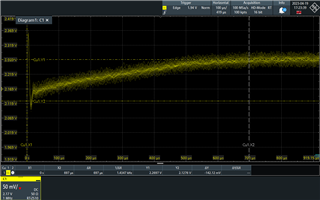Other Parts Discussed in Thread: OPA387, OPA388
Hello,
I have witnessed that the LMP2012 takes a long time to settle after the input signal switches from one value to another. This settling time and error depend on the amplitude of the signal (it can go up to 700 us and 100 mV of error for a dVout of 4.5V). The gain was also found to have an influence (the greater the gain, the greater the error).


I have observed this phenomenon under different supply voltages (dual/single supply), configurations (inverting/non-inverting), different loads and different feedback impedances. (These waveforms were obtained with a LMP2012 in a non-inverting configuration with a gain of 20 (19k feedback resistor and 1k resistor to ground), and a 1k resistor as load)
I was wondering if this could be caused by the auto-zeroing technique: could it be overcompensation of the offset voltage as the input voltage changes rapidly? Is it linked to the offset calibration time parameter in the datasheet?
Regards
Tamara

